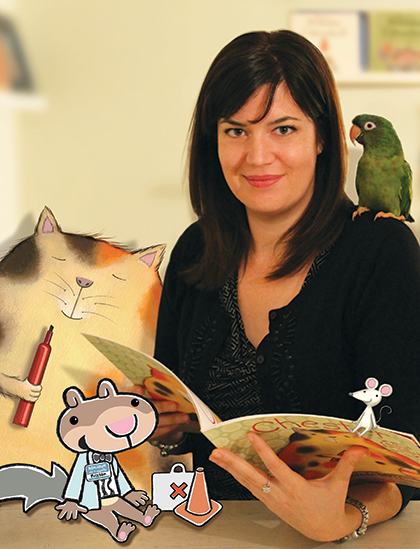Watt, Mélanie
Mélanie Watt’s Bright Ideas
Never doubt the power of a teacher. Of Michelle Lemieux, the creator of Stormy Night, and her professor, Mélanie Watt states that “It is because of her that I do what I do today.” Lemieux assigned the class to create a book about color and “for some reason, I decided to create a kid’s book,” remembers the author of Scaredy Squirrel. The gifted student came up with Leon the Chameleon and a book about complementary colors that so impressed the author/illustrator/professor that she sent Watt’s mockup to Kid’s Can Press. That is how a graphic design major became a published author/illustrator before graduation.
A native French-speaker from Québec, Mélanie wrote the book in French and then translated the text herself at the request of her professor. Now, her method is to write the book in English first and then translate it into her native tongue as she goes along. This presents special challenges as well as unique solutions: “Working in two languages, I always think about my jokes functioning in both languages with wordplays and things like that.” In case you are wondering, the French Canadian edition goes through another adaptation for the French European audience because they have a different sense of humor.
Once she found the world of children’s books, ideas bubbled out. Another pre-graduation idea that became a series was the Learning with Animals concept books, also published by Kids Can Press. Lemieux’s encouragement was key because the young illustrator evolved from writing words to fill out the page to creating a text that was an integral part of the book experience.
Having started on this path, Mélanie continues to like the control that comes from creating both the words and the art. Invoking her two most famous characters, she reveals that “I’m like Scaredy and Chester at once–I get control so that whatever I can’t say with words I’ll say with image, and what I can’t communicate with image, I’ll say with words.”
It’s hard to remember how revolutionary her approach was for Scaredy Squirrel. Looking back, it is obvious that Watt has been a major influence in this new golden age of children’s books. That structure grew out of her graphic design background. “It’s like telling a story with images,” she recalls. “I made a link for some reason for the concept between the society of fear around us–signals, panels, warnings, etc.–and the idea was to deconstruct the book in a way that lists these graphically.” No one was quite sure what to make of it. “Even the publisher wasn’t sure in the beginning if this was going to be clear for kids,” adds Mélanie.
“I’ve learned a lot about kids and teachers and how they teach through the letters they send to me.” People assume that she researched this approach before she created the book but that is not the case. Mélanie was not a big reader as a child so the idea of using the least amount of text to tell something is appealing to her.” She slyly adds “that there are a lot of words on her maps.”
Scaredy Squirrel is an excellent model for teachers who want to communicate a variety of text types. She has heard lots of ideas–“Teachers pick a topic and have kids give it the Scaredy treatment by having the students draw their fears and really look at pros and cons.” Mélanie also notes that “The approach is easy to mimic for a kid.” She also hears from people who work with autistic kids–“I did not know that the structure of these books is similar to how teachers work with these special needs kids so that’s fascinating to me,” she confides.
The audience is not limited to children or teachers. The fact that adults buy the book as well as teens and people with disabilities intrigues the author as well. “The audience is so broad because people really relate to the fear aspect” she notes, but goes on to say that “Scaredy Squirrel was my first attempt to be funny.”
Her next book, Bug in a Vacuum, represents a departure from the usual 32-page picture book. This 96-page book took the author/illustrator a year to complete. Curious about the subject? Think about the title–Bug in the Vacuum–and put that into the context of the five stages of grief. Mélanie is not leaving her fears behind–“that bug in a vacuum is going to go through a lot.”
Did her immediate success build up her confidence? “It took me years to actually say that I was an author, I saw myself more as a visual artist.” Mélanie doesn’t do school visits much these days. She is more at home in her studio, creating the books that spark children to deconstruct the fear in their own lives.
Interviewed by Ellen Myrick, December 2014
Click here for titles available in the BTSB Bookstore from this author

